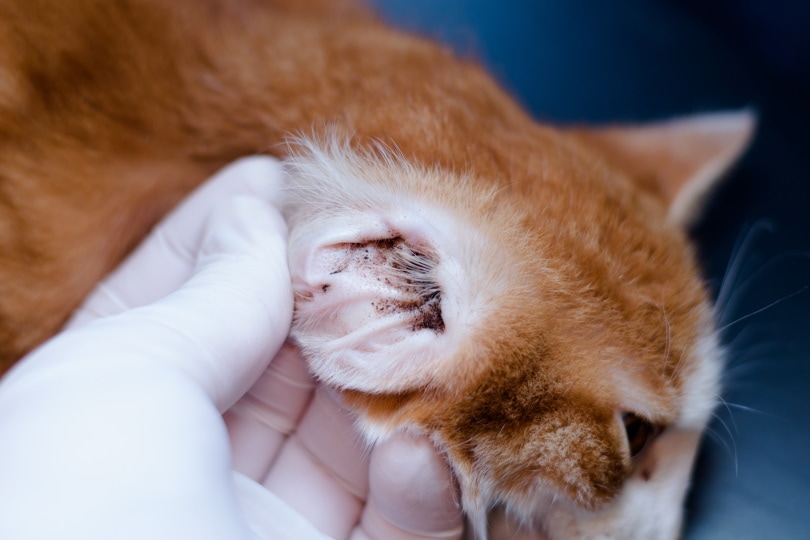
Click to Skip Ahead
If your furry friend seems restless and constantly scratches its ears, you may wonder whether it has an ear infection. Could it be ear mites? If yes, how urgently do you need to deal with the problem?
Generally, you can tell your cat has ear issues if it’s also shaking its head to relieve the itch from bites and has red, inflamed areas inside the ears.
Do you suspect your cat has ear mites? Read on to learn more about the cause of ear mites. We will also discuss the signs to look out for and what to do if your furry buddy has an infection.
Overview of Cat Ear Mites
Ear mites are tiny parasites barely seen by the naked eye. However, if you look closely, you might be able to notice white dots inside your cat’s ear canal. Under a microscope, it’s easier to see the critters crawling around the ear canal’s debris.
The most common cat ear mites are Otodectes cynotis. These mites cannot fly or hop but can spread from one animal to another by hitchhiking rides.
Although cat ear mites don’t tend to infest humans, it’s best to quickly eradicate them for your furry friend’s sake. An infestation that’s out of hand can cause immense inflammation, itchiness, and swelling of the ear canal.
If left untreated, ear mites can travel to the middle and inner ear and cause severe ear infections, balance problems, or hearing loss.

What Causes Ear Mite Infestations in Cats?
Cat ear mites are highly contagious and can infest numerous animals, including dogs, ferrets, and rabbits. Most cats acquire the critter by coming into close contact with an infected animal. Cuddles, fights, or even sharing bedding, grooming items, or entertainment resources can quickly spread an infestation.
If you live in a multi-pet household, your cat can get the critters from other pets, especially those that roam outdoors. The mites hide on body fur before finding their way into the ear, where there’s less disturbance from your furry friend’s tongue or paws during self-grooming.
Most animal shelters and boarding facilities have strict measures or requirements that help protect the feline residents from possible infestations. Still, there is always a risk of your pet picking ear mites from such centers.
How Many Cat Ear Mites Make an Infestation?
Although it’s nearly impossible to spot one ear mite, just one female adult in your cat’s ears is a cause for alarm.
Cat ear mites multiply rapidly. One female can lay up to five eggs daily and 140 monthly. An egg takes up to four days to hatch and roughly three weeks to develop into an adult.
Another reason one ear mite can pose a major threat is that the critter is relatively long-lived, with a life expectancy of up to two months. During this period, the mite will constantly reproduce, making the infestation go from bad to worse in just a few weeks.
How Can You Tell if Your Cat Has Ear Mites?
The easiest way to tell if your cat has ear mites is to do a quick visual check.
Felines don’t usually need much ear cleaning, and over-cleaning can cause irritation. Still, you should check their ears routinely and gently wipe them down after every two to three months.
Furthermore, you should examine your pet if it seems restless and its outer ear is inflamed. Other indicators that could suggest an ear mite infestation include the following.
One of the critical signs of cat ear mites is a dark waxy or crusty discharge that looks like coffee grounds. The debris is a mixture of ear mite poop, blood, and wax. It is also common for infected cats to scratch their bodies excessively, as some mites wander to explore other parts of their host.

How Is a Cat Ear Mite Infestation Diagnosed?
Cat ear mites are barely visible. You can miss an infestation if you merely peep into your furry friend’s ears during the early stages of an infestation. If nothing seems amiss, but your pet is scratching and pawing its ears excessively, it would be time to consult your vet.
Diagnosing ear mites involves first using an otoscope to shine light into the ear canal and check for signs of the parasites. Your vet will also use an ear swab to take samples of the ear discharge before doing a microscopic examination.
If it is confirmed that your furry friend has ear mites, the expert will devise the best course of treatment.
It is common for cats to scratch their ears excessively and shake their heads when they have an ear infection. If these signs are not caused by ear mites, your vet could suggest blood work and other diagnostic tests to unveil the root cause of the discomfort.

What Is the Treatment for Cat Ear Mites?
Treating an ear mite infestation will often not happen over a single appointment. Most treatments continue for three to four weeks to ensure the medication clears up all eggs and mites. Fortunately, the itchiness and discomfort quickly subside as soon as the medicine takes effect.
The first course of treating cat ear mites is to clean the ears thoroughly. This helps to remove most of the parasites and their debris. It also provides relief and soothes irritated areas. Most importantly, it is easier and quicker for medication to penetrate clean ears.
During treatment, your vet may also recommend ongoing ear cleaning. This will be necessary to help remove debris and keep the medication effective.
Some of the common treatments for cat ear mites include the following.
Medicated Ear Drops
Anti-parasitic ear drops are pretty effective at killing cat ear mites. However, you must use them for at least three weeks to ensure you eradicate all mites at different life stages. For the best outcome, follow your vet’s instructions to the letter.
Topical Medications
Topical antibiotics, anti-inflammatories, and antifungals are necessary to prevent or treat possible secondary bacterial or fungal infections. They are easy to use and often come in the form of a gel or ointment.
Oral Medications
Your veterinarian might also prescribe oral medication to treat your cat’s ear mites. Some treatments are repeated every 15 days, but others have a monthly or bi-monthly application. This will help ensure that the infestation is effectively eradicated and will protect your cat against reinfestations.

Can I Prevent Ear Mites in My Cat?
It is not entirely possible to protect your furry friend from ear mites. However, you can take steps to minimize the risk of an infestation. First, it is crucial to recognize the signs of ear mites and consult your vet immediately if you suspect an infection.
Here are other tips that will come in handy.
Keep Your Cat Indoors
Regardless of breed, domestic cats can happily live all their lives indoors. The surest way to protect your furry companion from ear mites is to keep it inside your home and provide plenty of entertainment opportunities. This should limit its contact with other possibly infected animals visiting your yard.
Before perceiving your home as an ear mite-free zone, ensure all household pets are examined and treated. Have your vet run the necessary tests even if they don’t show signs. Any untreated resident pet can easily trigger a re-infestation.
Do Regular Ear Checks
It’s helpful to routinely take a sneak peek into your furry friend’s ears during petting sessions. Check for inflammation, dirt, or discharge. Use vet-approved cleaners to remove debris whenever necessary. Most importantly, consult your vet if you notice something that seems off.

Keep Your Home Clean
Ear mites love hiding inside the ears, on your pet’s fur, or even on bedding. To keep an infestation at bay, clean your cat’s bedding in hot water each week and dry using your dryer’s fastest and hottest settings. Also, vacuum your interior spaces regularly, especially around areas frequented by your pets.
Seek Preventative Treatments
If your cat has a social life outside your home, you cannot underestimate the need to invest in preventative treatments. Outdoor play dates or a trip to a boarding facility pose a risk of an ear mite infection. Monthly prevention treatments can help keep your mind at ease, irrespective of your pet’s ups and downs.
Final Thoughts
Cat ear mites are tiny, pesky parasites. Although not deadly, they can make life miserable for your furry friend by causing intense discomfort and irritation. It will help to visit your vet immediately if you notice distressing signs like head shaking or excessive scratching of the ears.
Early treatment is the surest way to avoid secondary bacterial or yeast ear infections. Ear mites are pretty easy to eradicate, especially if you are not dealing with a full-blown infestation. Just ensure you manage your pet’s recovery, as your vet recommends preventing the possible relapse of signs.
Featured Image Credit: effective stock photos, Shutterstock







